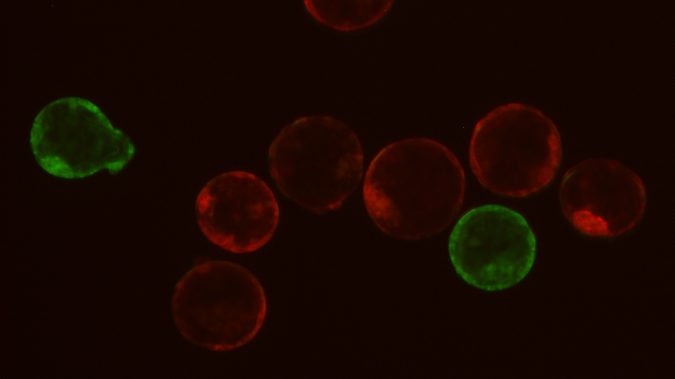
Genome Engineering & Model Generation
- Postdoctoral fellow:
- Laboratory manager:
- Technician:
- Laboratory technicians:
We offer full service for design and creation of customized mouse and rat mutant models. In addition, we are ready to assist you with model generation using tools created in your lab.
Selected published models generated by our team:
Ziak J, Weissova R, Jeřábková K, Janikova M, Maimon R, Petrasek T, Pukajova B, Kleisnerova M, Wang M, Brill MS, Kasparek P, Zhou X, Alvarez-Bolado G, Sedlacek R, Misgeld T, Stuchlik A, Perlson E, Balastik M. “CRMP2 mediates Sema3F-dependent axon pruning and dendritic spine remodeling.“ EMBO Rep. 2020
Wald T, Spoutil F, Osickova A, Prochazkova M, Benada O, Kasparek P, Bumba L, Klein OD, Sedlacek R, Sebo P, Prochazka J, Osicka R. “Intrinsically disordered proteins drive enamel formation via an evolutionarily conserved self-assembly motif.” Proc Natl Acad Sci U S A, 2017
Kasparek P, Ileninova Z, Zbodakova O, Kanchev I, Benada O, Chalupsky K, Brattsand M, Beck I, Sedlacek R. “KLK5 and KLK7 ablation fully rescues lethality of Netherton Syndrome-like phenotype” PLOS Genetics, 2017
Flemr M, Malik R, Franke V, Nejepinska J, Sedlacek R, Vlahovicek K, Svoboda P. “A retrotransposon-driven dicer isoform directs endogenous small interfering RNA production in mouse oocytes.” Cell, 2013
Custom Models Generation From Design to Delivery of a Mutant Line (Knock-out, Knock-in, Conditional, Point Mutation and Humanized Models)
We will discuss with you your project, propose an optimal model and prepare a targeting strategy to obtain the desired model with maximum efficiency. All the steps necessary to complete the project will be taken by our experts, to take advantage of our established and optimized pipelines for mutant model production.
We use state-of the art technologies for generation of custom rat and mouse mutant models, such as TALENs, CRISPR-based tools (Cas9, Cas12a), Easi-CRISPR and others. We are constantly following new trends in rodent transgenesis and develop new tools that allow us faster, cheaper and more efficient production of rodent models.
Do you have questions? Ask us
Microinjection electropora- tion services Pronuclear and ESC Injection, Zygote Electroporation
We are ready to help you with mutant model production using the targeting tools developed in your lab. All you need is to provide us with material (DNA construct, CRISPR/Cas mRNA or protein, ES cells) and we will perform zygote delivery and embryo-transfers using our established protocols.
Pronuclear Injection
Generation of transgenic mice will be performed by pronuclear injection (PNI) of fertilized oocytes. This technique is the most common and convenient way to make transgenic mice although it has also some shortcomings such as multiple transgene copies, occasional mosaic founders, expression levels do not correlate well with copy number, etc. Despite of these limitations PNI is often the quickest possibility to realize your project.In addition to the PNI of classic construct we offer also generation of transgenic animals using BACs (bacterial artificial chromosomes) and transposons. BAC transgenes usually have several advantages over transgenes produced by classic constructs; they give more physiological expression levels, are not susceptible to epigenetic inactivation, and give expression in proportion to copy number.To generate transgenic mice we use donor oocytes derived from superovulated C57BL/6N mice. Investigator/customer has to provide DNA-construct prepared according to the protocol (see the Protocols section). Purity of the DNA is a critical point in the generation of transgenic mice.
ES Cell Injection
The Transgenic Unit can culture and microinject ES cells for customers who have either generated targeted clones in their lab or obtained ES cell clones from another source. The provided ES cells are microinjected into the eight-stage cell embryo using laser-assisted technology. The injected embryos are then surgically implanted into the oviducts of recipient females (foster mothers). We use C57BL/6 mouse colony for microinjection of 129-derived ES cells. Customers with ES cell lines derived from other strains should contact the head or supervisor of Transgenic Unit for additional information.As the maintenance of ES cells in a non-differentiated state is largely dependent on how the cells are treated/handled in the cell culture, we cannot guarantee that microinjections will result in the generation of chimeric mice or that chimeric animals that are produced will be germ-line competent when working with ES cell clones cultured outside our facility.
Zygote Electroporation
Zygote electroporation is a new developing technique for the delivery of targeting constructs into the embryos, which is recently becoming very popular in transgenic facilities all over the world. Zygote electroporation does not require a micromanipulator, it is less invasive, and technically simple. A quantity of embryos can be electroporated at a time instead of individual microinjection. Moreover, a key advantage of zygote electroporation seems to be in the fact that the development of embryos is much higher than after PNI.
Do you have questions? Ask us
Genome Engineering & Model Generation unit was upgraded and expanded with the support from OP RDE project CZ.02.1.01/0.0/0.0/18_046/0015861 CCP Infrastructure Upgrade II in the years 2020 – 2022 and currently it is being upgraded from the OP JAC project CZ.02.01.01/00/23_015/0008189 Upgrade of the large research infrastructure CCP III.

